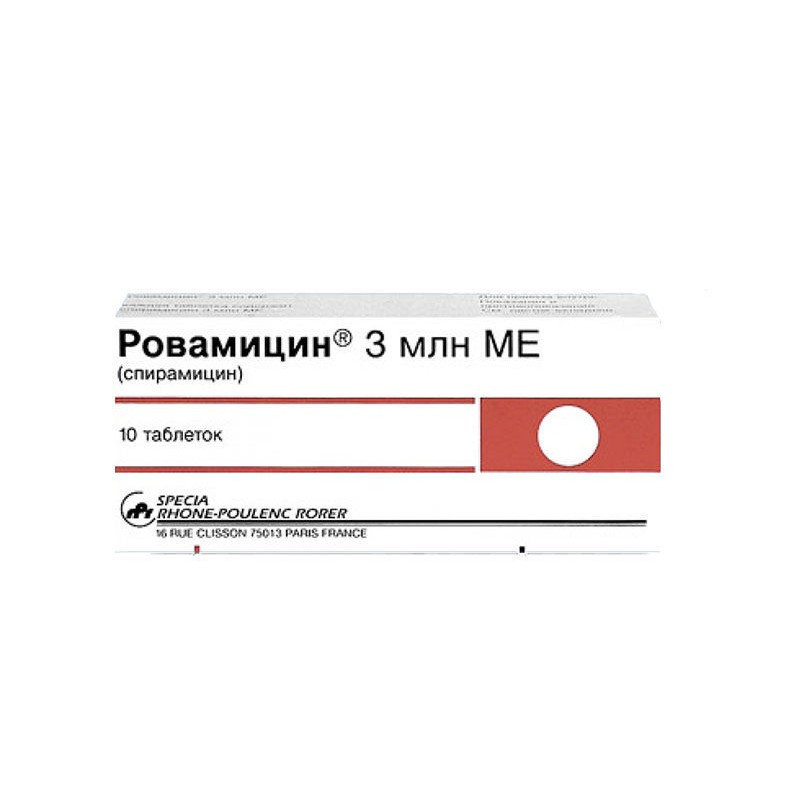



 All payments are encrypted via SSL
All payments are encrypted via SSL
 Full Refund if you haven't received your order
Full Refund if you haven't received your order
white or white with a cream shade of color, round, biconvex, engraved with "RPR 107" (table 1.5 million) or "ROVA 3" (table 3 million) on one side.
1 pill contains spiramycin 1.5 million IU or 3 million IU;
Excipients: colloidal anhydrous silicon, Magnesium stearate, pregelatinized starch, hydroxypropylcellulose, croscarmellose sodium (sodium carboxymethylcellulose), microcrystalline cellulose;
Shell composition: titanium dioxide, macrogol 6000, hypromellose;
8 pieces - Contour cell packages (2) - cardboard packs.
in blister 8 (for pills of 1.5 million IU) and 5 pcs. (for pills of 3 million IU); in a cardboard box 2 blisters.
Macrolide antibiotic. Acts bacteriostatic, disrupting intracellular protein synthesis.
Usually sensitive microorganisms: minimum inhibitory concentration (IPC) 4 mg / l): at least 50% of the strains are resistant - methicillin-resistant staphylococci, Enterobacter spp., Pseudomonas spp., Acinetobacter spp., Nocardia spp., Fusobacterium spp., Haemophilus spp. Mycoplasma hominis.
The spiramycin activity against Toxoplasma gondii has been proven in vitro and in vivo.
Due to the absence of clinical indications, some types of bacteria are not indicated in the spectrum. In France, from 20% to 25% of pneumococci are resistant to all macrolides (cross-resistance to all macrolides).
Spiramycin penetrates and accumulates in phagocytes (neutrophils, monocytes and peritoneal and alveolar macrobiophages). In humans, drug concentrations inside phagocytes are quite high. These properties explain the effects of spiramycin on intracellular bacteria.
For ingestion
Infectious and inflammatory diseases caused by microorganisms sensitive to the drug:
- infections of upper respiratory tract (sinusitis, tonsillitis);
- lower respiratory tract infections (including acute community-acquired pneumonia, including atypical pneumonia, exacerbation of chronic bronchitis);
- periodontal infections;
- infections of the skin and soft tissues (erysipelas, secondary infected dermatosis, impetigo, ecthyma, erythrasma);
- infections of bones and joints;
- infections of the reproductive system (not of gonorrhea);
- Toxoplasmosis in pregnant women.
Prevention of meningococcal meningitis in cases where rifampicin is contraindicated: eradication of Neisseria meningitidis in the nasopharynx. Spiramycin is not used to treat meningococcal meningitis. The drug is recommended for prophylaxis in patients after treatment, as well as in persons who had contact with the patient 10 days before his hospitalization.
Prevention of acute articular rheumatism in individuals with an allergic reaction to penicillins.
- lactation period;
- hypersensitivity to spiramycin and other components of the drug.
Rovamycine is not recommended for patients with deficiency of the enzyme glucose-6-phosphate dehydrogenase due to the possible occurrence of acute hemolysis.
WITH caution Rovamycine is prescribed for obstruction of the bile ducts or for liver failure.
For adults inside appoint 2-3 tab. 3 million IU or 4-6 tab. 1.5 million IU (ie, 6-9 million IU) per day in 2 or 3 doses. The maximum daily dose is 9 million IU.
Children weighing 20 kg or more the dose is 150-300 thousand IU / kg body weight / day, divided into 2-3 doses. The maximum daily dose in children is 300 thousand IU / kg body weight / day. Rovamycine pills of 3 million IU in children do not apply.
For the prevention of meningococcal meningitis for adults prescribe the drug in a dose of 6 million IU / kg body weight / day in 2 doses; for children 150 thousand IU / day in 2 divided doses.
due to the small renal excretion of spiramycin, a dose change is not required.
Gastrointestinal: nausea, vomiting, diarrhea and very rare cases (less than 0.01%) of pseudomembranous colitis. Isolated cases of ulcerative esophagitis and acute colitis are described. The possibility of the development of acute damage to the intestinal mucosa in patients with AIDS when using spiramycin in high doses for cryptosporidiosis (only 2 cases) was also noted. In very rare cases (less than 0.01%) - changes in liver function tests and the development of cholestatic hepatitis.
Nervous system: transient paresthesias.
Hemic and lymphatic: in very rare cases (less than 0.01%) - acute hemolysis and thrombocytopenia.
Cardiovascular: prolongation of the QT interval on the ECG.
Allergic reactions: skin rash, urticaria, itching; in very rare cases (less than 0.01%) - angioedema, anaphylactic shock.
Local reactions: rarely, moderately pronounced irritation along the vein, which only in exceptional cases may require cessation of treatment.
Perhaps the use of Rovamycine during pregnancy according to indications.
When prescribing Rovamycine during lactation, breastfeeding should be discontinued, since spiramycin may be excreted in breast milk.
No spiramycin teratogenic effects. Reducing the risk of transmission of toxoplasmosis to the fetus during pregnancy is observed from 25% to 8% when using the drug in the first trimester, from 54% to 19% in the second trimester and from 65% to 44% in the third trimester.
In patients with impaired liver function during the period of use of the drug should be monitored indicators of liver function.
With caution should use the drug in ergot alkaloids.
Treatment: if necessary, conduct symptomatic therapy. There is no specific antidote.
With simultaneous use with drugs containing a combination of levodopa and carbidopa, a decrease in the level of levodopa in plasma was observed.
Tablets should be stored in a dry place inaccessible to children at a temperature not higher than 25 ° C.
Lyophilisate should be stored in a dark place and out of reach of children at a temperature not exceeding 25 ° C.
